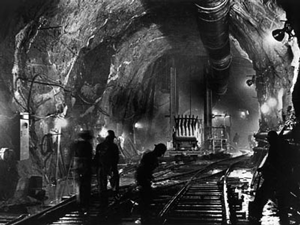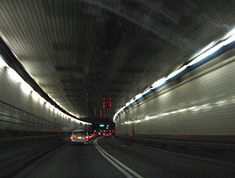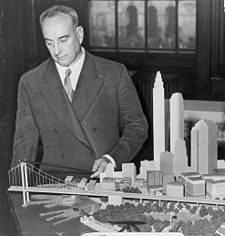|
University of Notre Dame Civil Engineering and Geological Sciences
2009
Junior Class Field Trip
New York City Infrastructure Basics
Field Trip Home
Links of Interest
| New York City's water supply system delivers approximateley 1.4 billion gallons of water each day to nearly 9 million people in the New York City region from two reservoir systems: Catskill/Delaware and Croton watershed, 95% of which is delivered to the consumer by gravity (The History of New York City's Water Supply System). New York City's water tunnels date from the early 1900s. Tunnel No. 1 (1917) and Tunnel No. 2 (1936) have been operating continuously since completion, but they leak badly in places and can not be shut down for repair without seriously disrupting NYC water supply. Tunnel No. 3 hopefuly will be the answer. The $6 billion, 60-mile-long
third tunnel which began its planning stages in the 1960s and its digging phase in 1970 is currently under construction and won't be completed until 2020. It burrows 450 to 800 ft below New York City. (By comparison, subways are typically 30 - 50 ft deep, and sewers are 10 - 15 feet deep.) Check out a map of the water system, and watch a day on the job NYC Underground: Travel 600 feet down on YouTube. |
 |
|
The need and desire for Manhattan island residents to connect with surrounding communities has driven the design and construction of some of the world's most impressive and historically significant bridges and tunnels. Today, over 2,000 bridges and tunnels provide uninterrupted vehicular movement throughout the region. |
 |
Ten bridges in New York City have been awarded historical landmark status: Brooklyn (the oldest bridge that is open to passengers and vehicles), Manhattan, Queensboro, Washington, University Heights, Carroll Street, Macombs Dam, George Washington, Highbridge (an aqueduct bridge and the oldest bridge still standing), and Hell Gate Bridge. New York's first bridge, King's Bridge, was constructed in 1693 and is no longer standing today.
Early bridge designers include John A. Roebling, who designed the Brooklyn Bridge (1883), the oldest suspension bridge in the United States, and Gustav Lindenthal , who designed the Manhattan Bridge (1909) Queensboro Bridge (1909) and Hell Gate Bridge (1917) which, at the time of completion, was the longest and heaviest steel arch bridge in the world.
Lindenthal's dream of spanning the Hudson with a massive bridge was realized by his Hell Gate Bridge assistant, Othmar Ammann, another long span bridge designer, and designer of six big New York bridges including the George Washington Bridge (1931), Triborough Bridge (1936), Verranzano-Narrows Bridge (1964).
|
While some were working to bridge over the Hudson River, others were working to tunnel under: Holland Tunnel (1927, one of earliest examples of ventilated design, and the first vehicular tunnel); Lincoln Tunnel (three tubes: 1937, 1945, 1957) and the Queens-Midtown Tunnel (1940) all were designed by Ole Singstad, who pioneered the ventilation system that made long underwater road tunnels possible. Singstad, who designed tunnels with an eye to the future, famously said when designing Baltimore's Harbor Tunnel - "Nothing is too good for Baltimore. I am building you a tunnel to last one thousand years."
A recent tunneling example is the 63rd Street Line of the New York City Subway, built between 1960 and 2001 using the immersed tube method. |
 |

|
Read about the man who played one of the largest roles in shaping the physical environment of New York City in the 20th century. Robert Moses, Master Builder. He is responsible for the building of a hugh state park system, highways, parkways, bridges, playgrounds, housing, tunnels, beaches, zoos, civic centers, and exhibition halls. He was a controversial figure as he embraced the automobile age and didn't worry about its impact on the city, and was often criticized for valuing automobiles more than people. Moses once said, "Those who can, build. Those who can't, criticize."
Today, New York's mass public transit system makes New York City one of the most energy efficient cities in the United States. Gasoline consumption in the city today is at the rate of the national average in the 1920s (http://en.wikipedia.org/wiki/Transportation_in_New_York_City) New York has the largest subway system in the world (based on track mileage), and the city is continuing to be transformed by massive transportation construction. Calatrava's World Trade Center Transportation Hub will connect 13 subway lines and link pedestrians to the World Financial Center, Hudson River ferry terminals, PATH trains, and potentially a direct rail link to JFK International Airport. |
|






